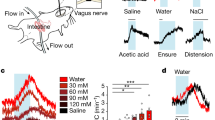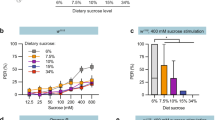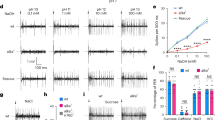Abstract
Sodium is essential for all living organisms1. Animals including insects and mammals detect sodium primarily through peripheral taste cells2,3,4,5,6,7. It is not known, however, whether animals can detect this essential micronutrient independently of the taste system. Here, we report that Drosophila Ir76b mutants that were unable to detect sodium2 became capable of responding to sodium following a period of salt deprivation. From a screen for cells required for the deprivation-induced sodium preference, we identified a population of anterior enteric neurons, which we named internal sodium-sensing (INSO) neurons, that are essential for directing a behavioural preference for sodium. Enteric INSO neurons innervate the gut epithelia mainly through their dendritic processes and send their axonal projections along the oesophagus to the brain and to the crop duct. Through calcium imaging and CaLexA experiments, we found that INSO neurons respond immediately and specifically to sodium ions. Notably, the sodium-evoked responses were observed only after a period of sodium deprivation. Taken together, we have identified a taste-independent sodium sensor that is essential for the maintenance of sodium homeostasis.
This is a preview of subscription content, access via your institution
Access options
Access Nature and 54 other Nature Portfolio journals
Get Nature+, our best-value online-access subscription
$29.99 / 30 days
cancel any time
Subscribe to this journal
Receive 12 digital issues and online access to articles
$119.00 per year
only $9.92 per issue
Buy this article
- Purchase on Springer Link
- Instant access to full article PDF
Prices may be subject to local taxes which are calculated during checkout




Similar content being viewed by others
Data availability
Raw data are presented in the repository at https://doi.org/10.6084/m9.figshare.22188652 (ref. 39). Reagents and flies used in this study are available via the corresponding author on request. Source data are provided with this paper.
Code availability
No custom code was used for this study.
References
Kurlansky, M. Salt: a World History (Penguin Books, 2003).
Zhang, Y. V., Ni, J. & Montell, C. The molecular basis for attractive salt-taste coding in Drosophila. Science 340, 1334–1338 (2013).
Chandrashekar, J. et al. The cells and peripheral representation of sodium taste in mice. Nature 464, 297–301 (2010).
Nomura, K., Nakanishi, M., Ishidate, F., Iwata, K. & Taruno, A. All-electrical Ca2+-independent signal transduction mediates attractive sodium taste in taste buds. Neuron 106, 816–829 (2020).
Oka, Y., Butnaru, M., von Buchholtz, L., Ryba, N. J. & Zuker, C. S. High salt recruits aversive taste pathways. Nature 494, 472–475 (2013).
Dweck, H. K. M., Talross, G. J. S., Luo, Y., Ebrahim, S. A. M. & Carlson, J. R. Ir56b is an atypical ionotropic receptor that underlies appetitive salt response in Drosophila. Curr. Biol. 32, 1776–1787 (2022).
Jaeger, A. H. et al. A complex peripheral code for salt taste in Drosophila. Elife https://doi.org/10.7554/eLife.37167 (2018).
Duncan, C. J. Salt preferences of birds and mammals. Physiologic. Zool. 35, 120–132 (1962).
Lindemann, B. Receptors and transduction in taste. Nature 413, 219–225 (2001).
McDowell, S. A. T., Stanley, M. & Gordon, M. D. A molecular mechanism for high salt taste in Drosophila. Curr. Biol. 32, 3070–3081 (2022).
Rucker, A. J., Rudemiller, N. P. & Crowley, S. D. Salt, hypertension, and immunity. Annu Rev. Physiol. 80, 283–307 (2018).
Dus, M., Ai, M. & Suh, G. S. Taste-independent nutrient selection is mediated by a brain-specific Na+/solute co-transporter in Drosophila. Nat. Neurosci. 16, 526–528 (2013).
Dus, M. et al. Nutrient sensor in the brain directs the action of the brain–gut axis in Drosophila. Neuron 87, 139–151 (2015).
Kim, B. et al. Response of the microbiome-–gut–brain axis in Drosophila to amino acid deficit. Nature 593, 570–574 (2021).
Li, M. et al. Gut-brain circuits for fat preference. Nature 610, 722–730 (2022).
de Araujo, I. E. et al. Food reward in the absence of taste receptor signaling. Neuron 57, 930–941 (2008).
Sclafani, A. From appetite setpoint to appetition: 50 years of ingestive behavior research. Physiol. Behav. 192, 210–217 (2018).
Lin, H. H. et al. A nutrient-specific gut hormone arbitrates between courtship and feeding. Nature 602, 632–638 (2022).
Tan, H. E. et al. The gut–brain axis mediates sugar preference. Nature 580, 511–516 (2020).
Tellez, L. A. et al. Separate circuitries encode the hedonic and nutritional values of sugar. Nat. Neurosci. 19, 465–470 (2016).
Walker, S. J., Corrales-Carvajal, V. M. & Ribeiro, C. Postmating circuitry modulates salt taste processing to increase reproductive output in Drosophila. Curr. Biol. 25, 2621–2630 (2015).
Lim, S. Y. et al. Identification and characterization of GAL4 drivers that mark distinct cell types and regions in the Drosophila adult gut. J. Neurogenet. 35, 33–44 (2021).
Miguel-Aliaga, I., Jasper, H. & Lemaitre, B. Anatomy and physiology of the digestive tract of Drosophila Melanogaster. Genetics 210, 357–396 (2018).
Luan, H., Peabody, N. C., Vinson, C. R. & White, B. H. Refined spatial manipulation of neuronal function by combinatorial restriction of transgene expression. Neuron 52, 425–436 (2006).
Hamada, F. N. et al. An internal thermal sensor controlling temperature preference in Drosophila. Nature 454, 217–220 (2008).
Klapoetke, N. C. et al. Independent optical excitation of distinct neural populations. Nat. Methods 11, 338–346 (2014).
Masuyama, K., Zhang, Y., Rao, Y. & Wang, J. W. Mapping neural circuits with activity-dependent nuclear import of a transcription factor. J. Neurogenet. 26, 89–102 (2012).
Nicolai, L. J. et al. Genetically encoded dendritic marker sheds light on neuronal connectivity in Drosophila. Proc. Natl Acad. Sci. USA 107, 20553–20558 (2010).
Zhang, Y. Q., Rodesch, C. K. & Broadie, K. Living synaptic vesicle marker: synaptotagmin-GFP. Genesis 34, 142–145 (2002).
Dana, H. et al. High-performance calcium sensors for imaging activity in neuronal populations and microcompartments. Nat. Methods 16, 649–657 (2019).
Wang, J. W., Wong, A. M., Flores, J., Vosshall, L. B. & Axel, R. Two-photon calcium imaging reveals an odor-evoked map of activity in the fly brain. Cell 112, 271–282 (2003).
Laragh, J. H. & Sealey, J. E. Renin–angiotensin–aldosterone system and the renal regulation of sodium, potassium, and blood pressure homeostasis. in (ed. Windhager, E. E.) Handbook of Physiology - Section 8: Renal Physiology. 1409–1541 (Oxford University Press, 1992).
Wolf, G., Schulkin, J. & Simson, P. E. Multiple factors in the satiation of salt appetite. Behav. Neurosci. 98, 661–673 (1984).
Qu, T., Han, W., Niu, J., Tong, J. & de Araujo, I. E. On the roles of the duodenum and the vagus nerve in learned nutrient preferences. Appetite 139, 145–151 (2019).
Liu, Y. et al. A gut–brain axis mediates sodium appetite via gastrointestinal peptide regulation on a medulla-hypothalamic circuit. Sci. Adv. 9, eadd5330 (2023).
Dus, M., Min, S., Keene, A. C., Lee, G. Y. & Suh, G. S. Taste-independent detection of the caloric content of sugar in Drosophila. Proc. Natl Acad. Sci. USA 108, 11644–11649 (2011).
Oh, Y. et al. A glucose-sensing neuron pair regulates insulin and glucagon in Drosophila. Nature 574, 559–564 (2019).
Zhan, Y. P., Liu, L. & Zhu, Y. Taotie neurons regulate appetite in Drosophila. Nat. Commun. 7, 13633 (2016).
Byoungsoo, K. & Hwang, G. Postprandial sodium sensing by enteric neurons in Drosophila. Figshare dataset https://doi.org/10.6084/m9.figshare.22188652 (2024).
Acknowledgements
We thank M. Seo-hyun Kim and Yoojin Lee at KAIST for their assistance during the screen, and the members of the laboratory of G.S.B.S for stimulating discussion and comments on the paper. This work is supported by KAIST Chancellor’s fund and grants from Samsung Science and Technology Foundation (project no. SSTF-BA-1802-11) and National Research Foundation of Korea (NRF-2022M3A9F3082982, NRF-2021M3F3A2A01037365 and RS-2023-00255126) to G.S.B.S. The funders had no role in study design, data collection and analysis, decision to publish or preparation of the manuscript. NRF RS-2023-00255126 (leader grant) specifically funds the line of research on postprandial sodium sensing; yet other grants have assisted in setting up fly facilities and infrastructure in the laboratory.
Author information
Authors and Affiliations
Contributions
B.K. carried out the screen, and performed immunohistochemistry, CaLexA, calcium imaging, behaviour testing, cloning, statistical analyses and figure design together with G.H. S.-E.Y in the laboratory of Y.J.K. constructed split-GAL4 and LexA lines and collected the gut images using light-sheet microscopy. M.C.K. in the laboratory of J.W.W. assisted B.K. to perform the gut calcium imaging. G.S.B.S. supervised the project and provided intellectual support. B.K. and G.S.B.S. wrote the manuscript with inputs from other authors.
Corresponding author
Ethics declarations
Competing interests
The authors declare no competing interests.
Peer review
Peer review information
Nature Metabolism thanks Molly Stanley and the other, anonymous, reviewer(s) for their contribution to the peer review of this work. Primary Handling Editor: Yanina-Yasmin Pesch, in collaboration with the Nature Metabolism team.
Additional information
Publisher’s note Springer Nature remains neutral with regard to jurisdictional claims in published maps and institutional affiliations.
Extended data
Extended Data Fig. 1 Behavioral responses of another fly strain (Canton-S), and w1118 male and female flies reared in a defined diet (holidic media).
a Behavioral responses of 72-hour deprived control CS flies that had been fed 10 mM NaCl for 24 hours prior to the two-choice task. N = 5. b Behavioral responses of w1118 male and female flies with or without 72 hours of salt deprivation in holidic media that lack sodium.N = 7-8. Data showed as mean values ± s.e.m. Individual p values are shown in the source data file. **p < 0.01, *p < 0.05: one-way ANOVA with Tukey’s post-hoc test in a, unpaired two-tailed t-test in b.
Extended Data Fig. 2 Two-choice behavioral responses to various concentrations of NaCl in control, IR76b mutant male and female flies after 72 hours of salt deprivation.
a-e. Behavioral responses of control w1118 mated female (a), male (b), virgin female (e) flies and IR76b mutant mated female (c), male (d) flies in the two-choice assay after 72 hours of salt deprivation. Deprived and sated flies were given a choice between 20 mM sucrose and 20 mM sucrose mixed with different NaCl concentrations (5 mM, 10 mM, 20 mM, 50 mM, 200 mM). N = 5. All graphs in figure showed mean ± s.e.m. Individual p values are shown in the source data file. ***p < 0.001, **p < 0.01: two-way ANOVA with Bonferroni’s multiple comparisons test.
Extended Data Fig. 3 Male flies also display taste-independent preference for sodium following a period of salt deprivation.
Behavioral responses of 72-hour deprived control w1118 male flies that had been fed different sodium-containing salts (10 mM NaHCO3 or MSG) and chloride-containing salts (5 mM MgCl2 or CaCl2) for 24 hours prior to the two-choice task. N = 5-6. Data showed as mean values ± s.e.m. Individual p values are shown in the source data file. ***p < 0.001, ns: one-way ANOVA with Tukey’s post-hoc test.
Extended Data Fig. 4 A screen to identify cells that are required for the deprivation-induced NaCl preference.
The result of a screen using Janelia GAL4 lines crossed with tub-GAL80ts, UAS-kir2.1 for defects in the deprivation-induced preference for NaCl (10 mM) after 72 hours of salt deprivation. N = 2 in each Janalia GAL4 lines crossed with tub-GAL80ts, UAS-kir2.1 and N = 6 in control line w1118 line crossed with tub-GAL80ts, UAS-kir2.1. Bars indicate mean of individual n and data showed as mean values ± s.e.m.
Extended Data Fig. 5 GAL4 expression of R10H08, R59H02 and split combination in other tissues.
Representative confocal images in the CNS, gastrointestinal tract, ovary and fat body of flies bearing UAS-mCD8::GFP crossed to R10H08-GAL4 (left), R59H02-GAL4 (center), or split-GAL4 derived from R10H08 and R59H02 promoters (right). The specimens were probed with anti-GFP antibody (green), counterstained with phalloidin (blue) and DAPI (white). Scale bars, 200 μm (ovary), 100 μm (CNS), 50 μm (fat body) and 20 μm (R3, hind gut, rectum). n = 2–4 in each group.
Extended Data Fig. 6 Optogenetic stimulation of INSO neurons blunts the deprivation-induced preference and appetite for sodium.
a Behavioral responses of sated or 72-hour deprived Split-GAL4 lines crossed with UAS-Cschrimson that stimulated INSO neurons when light was on. N = 5. b Relative colorimetric quantifications of food intake in sated or 72-hours deprived Split-GAL4 lines crossed with UAS-Cschrimson that stimulated INSO neurons when light was on. N = 5–6. Data showed as mean values ± s.e.m. Individual p values are shown in the source data file. ***p < 0.001, **p < 0.01: unpaired two-tailed t-test.
Extended Data Fig. 7 Expression and function of AstC-R1+ enteric neuron on the proventriculus.
a A confocal image of anterior enteric neurons (green) labeled by AstC-R1-GAL4 crossed to UAS-CD8::GFP, and counterstained with phalloidin (blue). Scale bars, 20 μm. n = 5. b Behavioral responses of AstC-R1-GAL4 crossed to tub-GAL80ts, UAS-kir2.1 for inactivation of the anterior enteric neurons that were sated, 72-hour deprived, or refed with 10 mM NaCl for 6 and 24 hours prior to the two-choice assay. N = 5. c, d. Representative images of AstC-R1+ neurons in the brains of flies carrying AstC-R1-GAL4, UAS-tdtomato and UAS-CaLexA that were deprived (c) and re-sated with 50 mM NaCl (d). Native tdtomato (magenta) and GFP (green) fluorescence signals were visualized. Scale bars, 50 μm. n = 4 Data showed as mean values ± s.e.m. Individual p values are shown in the source data file. ***p < 0.001, **p < 0.01: one-way ANOVA with Tukey’s post-hoc test.
Extended Data Fig. 8 INSO split-GAL4 are response to sodium after deprivation.
a-e. Representative images of INSO neurons of flies carrying Split-GAL4, UAS-tdtomato and UAS-CaLexA, that were deprived (a), re-sated by the intake of NaCl (b), the intake of NaHCO3, MSG or Na2H2PO4 (c), and the intake of CaCl2, MgCl2 or NMDG-Cl (d), and the quantification (e) of CaLexA-derived native GFP fluorescence signals from INSO neurons of deprived, re-sated with denoted sodium-containing and chloride-containing salts. Native tdtomato (magenta) and GFP (green) fluorescence, counterstained with DAPI (blue) were illuminated. Dash lines outline the cell bodies of INSO neurons. Scale bars, 5 μm. n = 5–6. Data showed as mean values ± s.e.m. Individual p values are shown in the source data file. **p < 0.01, *p < 0.05, ns: one-way ANOVA with Dunnett’s multiple comparisons test.
Extended Data Fig. 9 Amounts of Food intake of flies that were sodium-deprived or re-sated.
a–b. Distribution of food intake of 72-hour deprived flies or 72-hour deprived flies that were fed 10 mM NaCl for 24 hours: w1118 male (a) and female (b) flies. N = 5. c Relative colorimetric quantifications of food intake in 72-hour deprived flies or 72-hour deprived flies that were fed 10 mM NaCl for 24 hours. N = 5. Bars indicate mean of individual n and data showed as mean values ± s.e.m. Individual p values are shown in the source data file. ns: two-way ANOVA with Bonferroni’s multiple comparisons test in a and b, unpaired two-tailed t-test in c.
Extended Data Fig. 10 INSO neurons innervated their neuronal processes to the brain and gut.
Representative confocal images of INSO neurons in the midgut, proventriculus, esophagus and the whole brains of flies carrying split R10H08-AD, R59H02-DBD and UAS-mCD8::GFP probed with anti-GFP (green), anti-NC82 (magenta) antibodies, counterstained with phalloidin (blue). Scale bars, 50 μm. n = 4.
Supplementary information
Supplementary Video 1
z-stack optical sections of the brain of a fly carrying INSO split R10H08-AD, R59H02-DBD, UAS-syt::GFP and UAS-Denmark probed with anti-GFP (green), anti-DsRed (red) and anti-NC82 (magenta).
Supplementary Video 2a
Representative ΔF/F of GCaMP fluorescence in INSO neurons of a fly carrying AstC-R1-GAL4 and UAS-GCaMP7c in response to a solution containing 0 mM NaCl.
Supplementary Video 2b
Representative ΔF/F of GCaMP fluorescence in INSO neurons of a fly carrying AstC-R1-GAL4 and UAS-GCaMP7c in response to a solution containing 100 mM NaCl.
Source data
Source Data Fig. 1
Fly lines, statistics and raw data of each graph and uncropped image source data.
Source Data Fig. 2
Fly lines, statistics and raw data of each graph and uncropped image source data.
Source Data Fig. 3
Fly lines, statistics and raw data of each graph and uncropped image source data.
Source Data Fig. 4
Fly lines, statistics and raw data of each graph and uncropped image source data.
Source Data Extended Data Fig./Table 1
Fly lines, statistics, sample size and raw data of each graph (numerical).
Source Data Extended Data Fig./Table 2
Fly lines, statistics, sample size and raw data of each graph (numerical).
Source Data Extended Data Fig./Table 3
Fly lines, statistics, sample size and raw data of each graph (numerical).
Source Data Extended Data Fig./Table 4
Fly lines, statistics, sample size and raw data of each graph (numerical).
Source Data Extended Data Fig./Table 5
Fly lines, statistics, sample size and raw data of each graph (numerical).
Source Data Extended Data Fig./Table 6
Fly lines, statistics, sample size and raw data of each graph (numerical).
Source Data Extended Data Fig./Table 7
Fly lines, statistics, sample size and raw data of each graph (numerical).
Source Data Extended Data Fig./Table 8
Fly lines, statistics, sample size and raw data of each graph (numerical).
Source Data Extended Data Fig./Table 9
Fly lines, statistics, sample size and raw data of each graph (numerical).
Source Data Extended Data Fig./Table 10
Fly lines, statistics, sample size and raw data of each graph (numerical).
Rights and permissions
Springer Nature or its licensor (e.g. a society or other partner) holds exclusive rights to this article under a publishing agreement with the author(s) or other rightsholder(s); author self-archiving of the accepted manuscript version of this article is solely governed by the terms of such publishing agreement and applicable law.
About this article
Cite this article
Kim, B., Hwang, G., Yoon, SE. et al. Postprandial sodium sensing by enteric neurons in Drosophila. Nat Metab (2024). https://doi.org/10.1038/s42255-024-01020-z
Received:
Accepted:
Published:
DOI: https://doi.org/10.1038/s42255-024-01020-z



